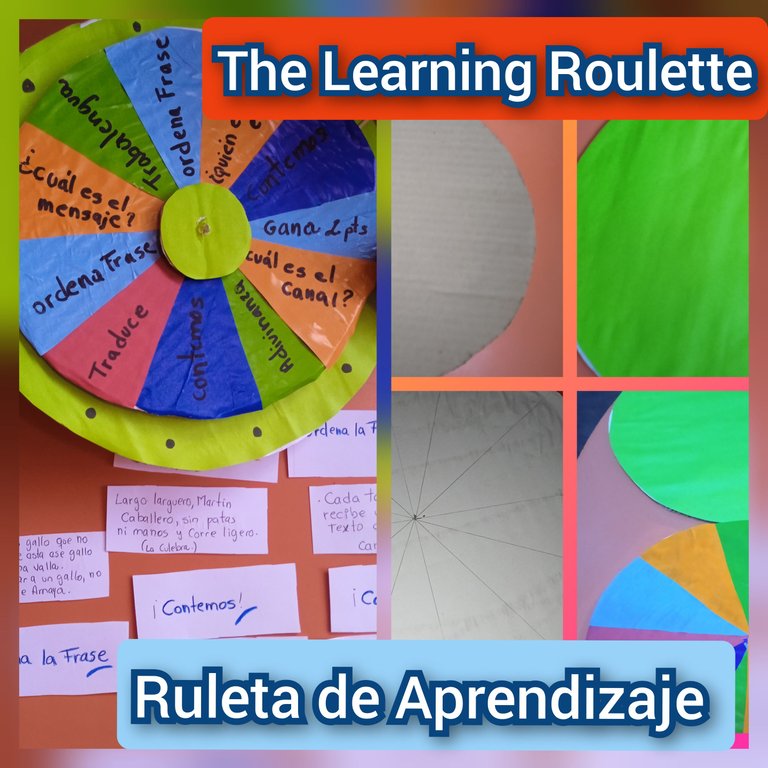
- Saludos Apreciados lectores de esta valiosa comunidad de homeedders, hoy te invito a elaborar una sencilla, pero divertida ruleta educativa. El tema en mi ruleta está centrado en la enseñanza del área de castellano, pero tú lo puedes adaptar a la edad y tema que requieras. Es una completa estrategia que activa todos los canales de aprendizaje en los niños. Recordemos que el juego lúdico para un aprendizaje más significativo.
Materiales Utilizados:
3 Hojas blancas
Lápiz y Tijera.
Cartón y una cartulina
Marcador de tinta indeleble Negro. (Marcador de pizarra acrílica)
Pega Blanca.
Una barrita de silicón
Papel lustrillo.
1 palito de altura.
2 ligas finas.
Como elaborar la Ruleta
1.- Corta primero la base de la ruleta en el cartón. La cual es una sola pieza de las siguientes medidas. En su base principal es de 8 cm de ancho por 20 centímetro de largo. Estos 20 cm de largo tienen la terminación como especie de embudo, y le das el ancho de tu preferencia. Este embudo será la parte alta en la cual fijarás el círculo de tu ruleta.
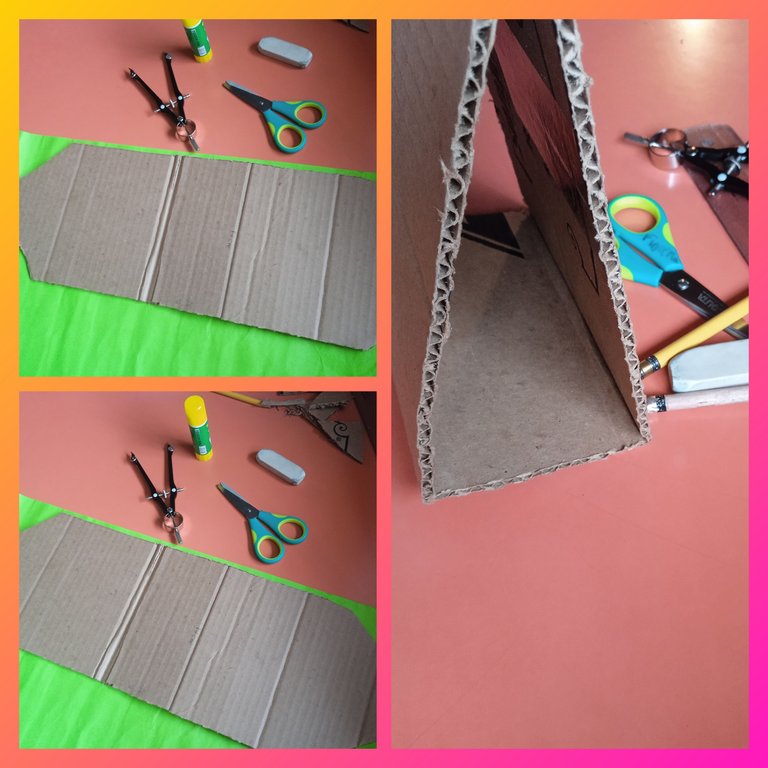
2.- Recorta 2 círculos, uno de 30 cm de diámetro y otro de 28 cm. Uno será tu base fija, y el otro la giratoria.
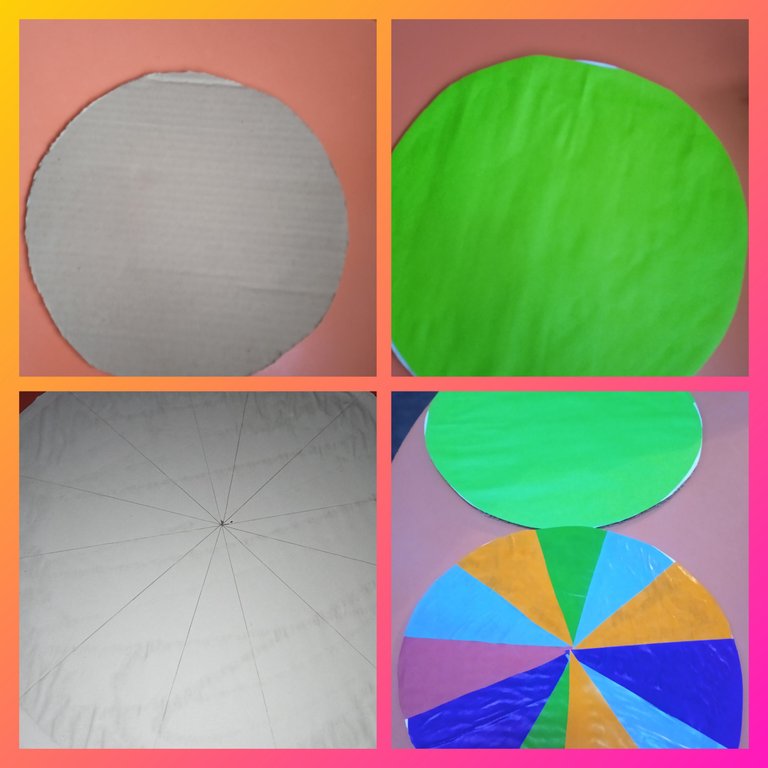
3.- Puedes pintar tus piezas de cartón elaboradas o forrar con cartulina de algún color que te agrade y sea llamativa para motivar el juego.
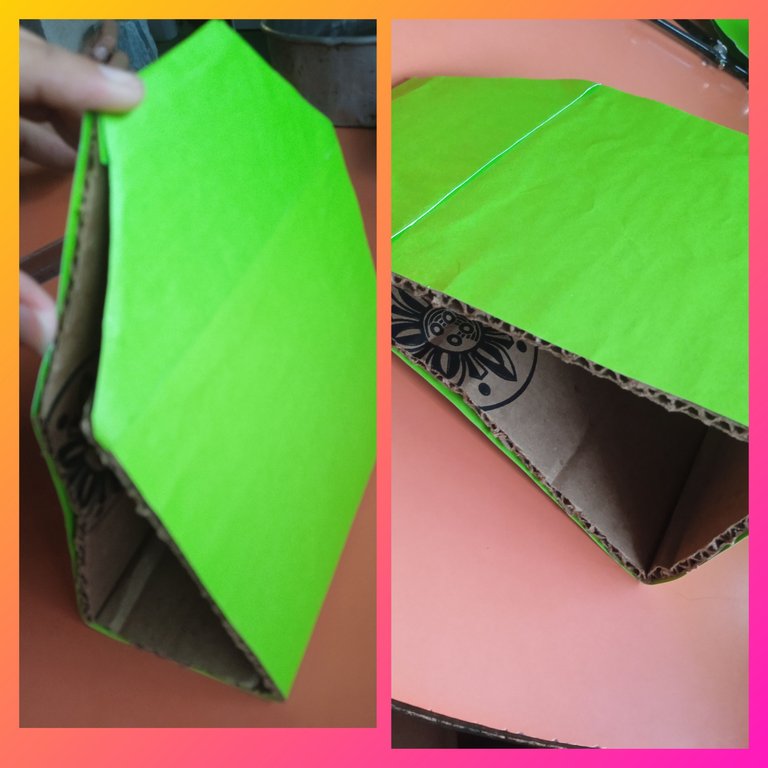
4.- La base de mi ruleta la forre con la cartulina verde, y procedí a pegar su extremo superior con la barra de silicón; a fin de que este lista y fija para cuando termine con el resto de las piezas.
5.- El Círculo más grande lo forre con cartulina verde. Mientras que el círculo más pequeño lo forre inicialmente con hojas blancas, porque en este voy a colocar pequeños triángulos de papel lustrillo. Para ello, divido mi circunferencia en 12 partes iguales.
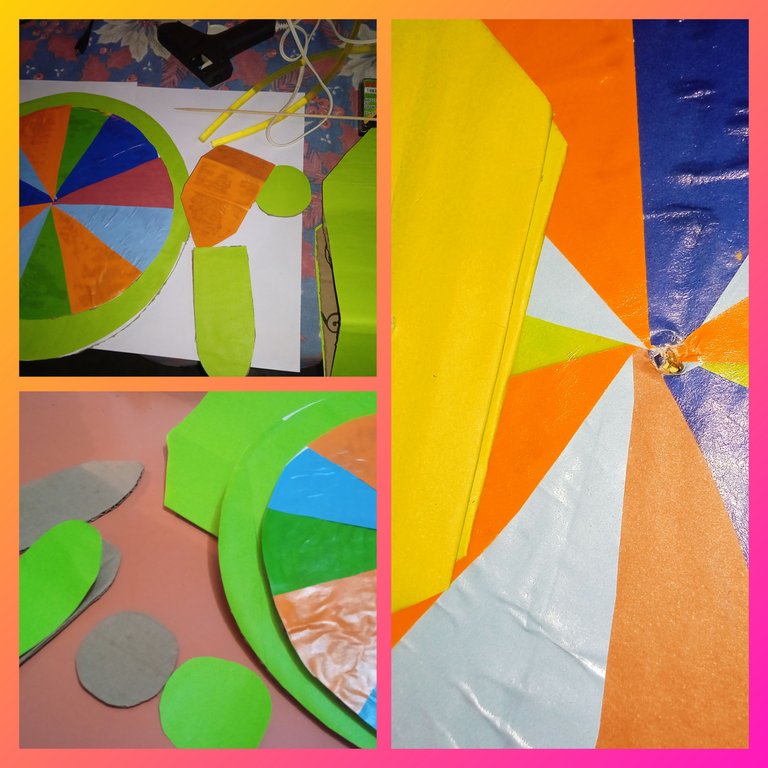
6.- Corta 12 triángulos de colores (papel lustrillo), a la misma medida que marcaste en tu circulo. Corta 2 piezas pequeñas de cartón de medidas 10cm x 4cm. Una será la flecha que indica el turno, y la otra servirá para hacer girar tu ruleta. Adicional recorta una pequeña circunferencia de 4cm de diámetro.
Una vez que tienes todas las piezas, Armamos nuestra ruleta de la siguiente manera:
- Abre con cuidado un orificio en ambos círculos, Justo en su centro. Perfora la base, en su parte superior con el palito de altura, de atrás hacia adelante. Coloca el círculo más grande, y agrega silicón en su parte posterior para fijar a la base. En ese espacio entre el círculo base y el círculo giratorio, vamos a colocar una de las ligas (dando vueltas alrededor del palito de altura) esto con la finalidad de que, al girar la ruleta, esta rebote y gire con facilidad sobre su eje.
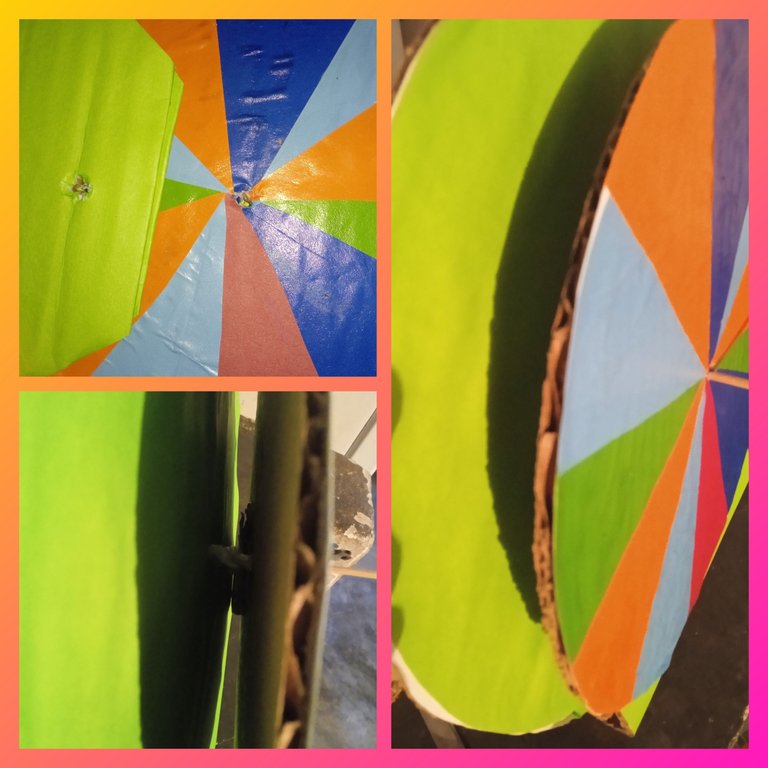
Del mismo modo en la parte superior de la base, justo donde sale el palito de altura, por la parte de atrás, colocamos la otra liga. Anudando y haciéndola girar alrededor del palito. Colocas el círculo giratorio, finalmente cortas para que no quede sobresaliente el palito de altura, y pegas el círculo de 4cm en la parte frontal
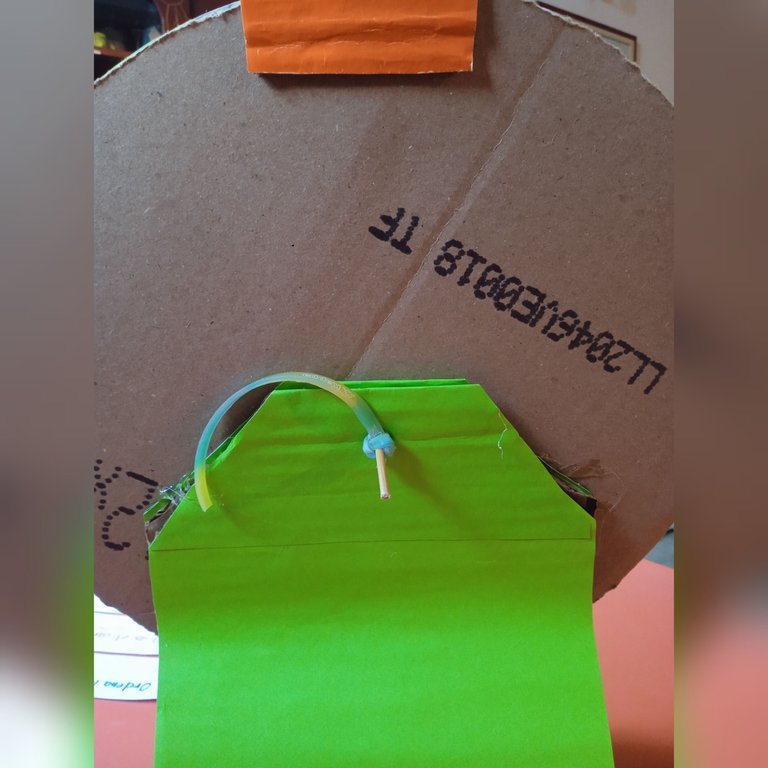
Estos últimos puntos son de gran importancia, ya que nos permiten el equilibrio al girar la ruleta.
Como llevar a cabo la Estrategia
En un salón de clases pueden ir tomando el turno de forma individual para girar la ruleta y participar, mientras que la docente hace las preguntas; o pueden conformar dos equipos para competir, y la docente lidera los giros de la ruleta y los turnos con la finalidad de que todos se integren.
Cada participante hace girar la ruleta y responde la pregunta según sea su caso que haya indicado la flecha.
Con cada respuesta acertada tiene 2 puntos. E inclusive hay una casilla en la cual gana automáticamente 2 puntos. Puedes variarla también, con premio o reto.Las actividades a realizar en la ruleta, van a variar dependiendo del grado, edad y tema que quieras abordar. En este caso la asignatura es castellano, por ende se colocaron diferentes preguntas referentes al proceso de comunicación, trabalenguas, ordena la frase, adivinanzas, y varios párrafos cortos con enunciados matemáticos. Como por ejemplo:
Ruleta ¿Quién es el emisor?
Tarjeta: Todas las mañanas Vicente le pide a su padre que le cuente una historia camino a la escuela.
Ruleta: ¡Contemos!
Tarjeta: Vicente esta cocinando 5 panes para cada integrante de la familia, dos llegan el sábado, tres viajan el día Domingo, y cuatro ya están en casa. ¿Cuantos panes debe cocinar?
Aportes de la Estrategia
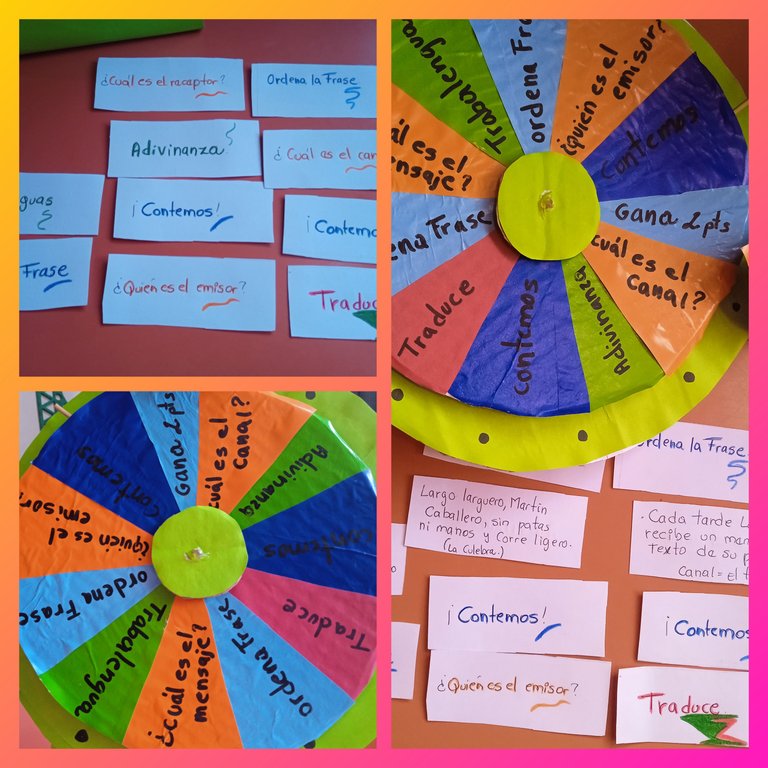
Gracias por visitarme,espero que esta nueva estrategia de aprendizaje,sea de utilidad para ti
Todas las imágenes son de mi propiedad, editadas en GidArt

English Version

- Greetings Dear readers of this valuable community of homeedders, today I invite you to create a simple but fun educational roulette. The theme in my roulette is focused on the teaching of Spanish, but you can adapt it to the age and theme you require. It is a complete strategy that activates all learning channels in children. Let's remember that the playful game for a more meaningful learning.
Materials Used:
3 white sheets of paper
Pencil and scissors.
Cardboard and a poster board.
Black indelible ink marker (acrylic whiteboard marker).
Pega Blanca.
A stick of silicone
Shine paper.
1 stick of height.
2 thin rubber bands.
1.- First cut the base of the roulette out of cardboard. Which is a single piece of the following measures. In its main base is 8 cm wide by 20 cm long. These 20 cm long have the end as a kind of funnel, and you give it the width of your preference. This funnel will be the high part in which you will fix the circle of your roulette.

2.- Cut out 2 circles, one of 30 cm in diameter and the other of 28 cm. One will be your fixed base, and the other the rotating one.

3.- You can paint your elaborate cardboard pieces or cover them with cardboard in a color that you like and is eye-catching to motivate the game.

4.- I lined the base of my roulette with green cardboard, and proceeded to glue its upper end with the silicone bar, so that it would be ready and fixed when I finished with the rest of the pieces.
5.- I lined the larger circle with green cardboard. While the smaller circle I lined it initially with white sheets, because in this one I am going to place small triangles of lustrillo paper. To do this, I divide my circumference into 12 equal parts.

6.- Cut 12 colored triangles (lustrillo paper), to the same size you marked on your circle. Cut 2 small pieces of cardboard measuring 10cm x 4cm. One will be the arrow that indicates the turn, and the other will be used to spin your roulette. In addition, cut out a small circumference of 4cm in diameter.
Once you have all the pieces, we assemble our roulette as follows:
- Carefully open a hole in both circles, right in the center. Pierce the base, at its top with the height stick, from back to front. Place the larger circle, and add silicone to the back of the circle to attach it to the base. In the space between the base circle and the rotating circle, we are going to place one of the rubber bands (going around the height stick) so that, when the roulette spins, it bounces and spins easily on its axis.

- In the same way on the top of the base, just where the height stick comes out, on the back side, we place the other garter. Knotting and spinning it around the stick. Place the rotating circle, finally cut it so that the height stick does not stick out, and glue the 4cm circle on the front part.

*These last points are of great importance, since they allow us to balance when spinning the roulette wheel.
In a classroom you can take turns individually to spin the wheel and participate, while the teacher asks the questions; or you can form two teams to compete, and the teacher leads the roulette spins and turns in order that everyone is integrated.
Each participant spins the roulette wheel and answers the question indicated by the arrow.
Each correct answer is worth 2 points. And there is even a box in which you automatically win 2 points. You can also vary it, with a prize or a challenge.The activities to do in the roulette, will vary depending on the grade, age and subject you want to address. In this case the subject is Spanish, therefore different questions were placed referring to the communication process, tongue twisters, order the sentence, riddles, and several short paragraphs with mathematical statements. For example:
Roulette Who is the sender?
Card: Every morning Vincent asks his father to tell him a story on the way to school.
Roulette: Let's count!
Card: Vincent is baking 5 loaves of bread for each member of the family, two arrive on Saturday, three travel on Sunday, and four are already home. How many loaves of bread should he bake?
Strategy Contributions

*Thank you for visiting me, I hope this new learning strategy will be useful for you.
*All the images are my property, edited in GidArt.
Hola @graciadegenios, una ruleta muy atractiva y colorida, además de estudiar el área de castellano se pueden incluir los colores, clasificación de los triángulos e iniciar el conteo de acuerdo a las divisiones de la ruleta, me gustó, es muy práctica para trabajar con los pequeños y está hecha con material de provecho que por lo general tenemos en casa.
Bendiciones!
Saludos amiga @belkyscabrera así es muy colorida, educativa y divertida.
Si! Es muy funcional, nos sirve para muchas áreas 🥳
Agradecida por su visita y tu valioso comentario 🤗
Hola, muy atractiva, colorida y sobre todo educativa que es lo que se quiere. Me imagino a los padres y amigos jugando esta ruleta, que viene con todo.
Saludos @nubra11 gracias por visitarme 🤗
Siii la combinación de colores y texturas para un juego educativo siempre incentivan todos los canales de aprendizaje. Y es motivador para niños y adultos 🤗 espero puedas disfrutar en casa de esta estrategia 🎉
The rewards earned on this comment will go directly to the people( @graciadegenios ) sharing the post on Twitter as long as they are registered with @poshtoken. Sign up at https://hiveposh.com.
Gracias infinitas por el apoyo y la compañía 🙏
Bendiciones para todo el equipo de @rutablockchain 😇
Ingeniosa estrategia!! Fácil construcción y de fácil aplicación en el aula. Un abrazo amiga
Gracias amiga.Me alegra que se entienda muy bien la construcción de la ruleta 🎉
Personalmente me gusta mucho porque se puede usar para varias áreas 🤗
Gracias por pasar a visitarme, se que eres un artista en creatividad y procesos manuales 💪
Me ha gustado esta ruleta de aprendizajes. Gracias por compartirla. Sin duda cualquier niño aprende y se divierte en ella.
Saludos y bendiciones
Saludos @leomarylm Gracias por tu apreciación 🤗
Estás en lo cierto, la podemos usar para enseñar colores,formas geométricas, palabras asociadas a sonidos, y de muchas otras forma más 🎉
Me alegra que te gustará 🤗
que lindo trabajo, puedes visitar nuestra comunidad infantil KIDS
que lindo trabajo, puedes visitar nuestra comunidad infantil KIDS
que lindo trabajo, puedes visitar nuestra comunidad infantil KIDS
Hi @graciadegenios I love these activities because they help children to speed up thinking and consolidate knowledge. Excellent work my friend
Saludos amiga Damarys 🤗
Así es,lo has resumido en tus líneas. Concentración,agilidad y consolidar los conocimientos 🎉
El juego es una excelente herramienta para consultar los procesos ☺️
Muchísimas Gracias por tu aporte en el comentario 💪
Congratulations your publication has been chosen among the best of the day.
KEEP CREATING GOOD CONTENT.
Thank you very much.It is truly an honor to receive this recognition.
The commitment to good content will continue.
Congratulations @graciadegenios! You have completed the following achievement on the Hive blockchain And have been rewarded with New badge(s)
Your next target is to reach 3250 replies.
You can view your badges on your board and compare yourself to others in the Ranking
If you no longer want to receive notifications, reply to this comment with the word
STOPCheck out the last post from @hivebuzz:
Dear @graciadegenios,
May I ask you to review and support the new HiveSQL Proposal so we can keep it free to use for the community?
You can do it on Peakd, ecency,
Thank you!